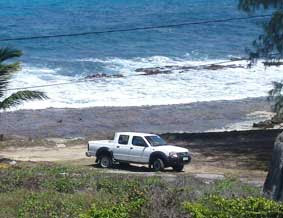David, my boss (see http://seychelles-whale-sharks.blogspot.com/), has asked me to write about a day in my life as a Turtle Officer. As I have never owned a diary in my life, nor had the desire to share my private thoughts on the internet, I hope you will bear with me.
Every morning I drag my sorry behind out of bed at around 7:30am (I use to jump out of bed with a spring in my step but the increasing daily air temperature and cost of living has a way of sucking the spring right out of you!). By 8:00am I am ready to leave, and head for the MCSS twin cab pick-up truck… otherwise known as my baby!
Elke’s baby; battered by turtle patrols over the years, photo Elke Talma
With luck, I will miss the traffic jam in Victoria as I make my way to the South of Mahé. Assuming I make it through traffic, avoid being stuck behind slow and/or stupid drivers and spot the traffic cops before they catch me on their radar gun, I will get to the first beach by 9:00am. I park in my usual spot (assuming a tourist did not get there first!), collect the turtle bag from the back seat (packed the night before), strap on my digital camera (the 3rd in 2 years, as sand grains are not very camera friendly), clip on my pepper spray (illegal in Seychelles, never been used but handy to have considering that I tend to do beach patrols alone) and grab my mobile phone in case of emergencies … since most of the nesting beaches do not have phone reception its more a security blanket than anything else!
 Map of Mahé showing MCSS office and Banyan Tree Resort.
Map of Mahé showing MCSS office and Banyan Tree Resort.
I make my way through the path in the dune vegetation and start trekking along beach #1 (beaches will remain nameless to protect nesting sites). Once on the beach, I usually head South first unless I see something at the North end ... a habit I have no desire to change should anyone want to question this! I walk the entire length of beach #1 looking of nesting turtles or tracks before heading back to the truck. I then make my way to beach #2, #3 etc ... where the process is repeated until I have done 7 beaches.
 Aerial shot of Intendance beach in the South of Mahé, photo Elke Talma
Aerial shot of Intendance beach in the South of Mahé, photo Elke Talma
While Hawksbill turtles are known to nest all year round in Seychelles, the peak nesting period doesn’t really start until October, so there is not much to see at this time of the year. Every season, the plan is to monitor the prime nesting beaches (known as “morning” beaches) at least 3 times a week during peak nesting period and at least once or twice a week the rest of the year to keep track of hatching nests but also for turtles nesting outside of the peak period.
 Hawksbill turtle tracks – if you are lucky you will see one at this time of the year, photo Elke Talma
Hawksbill turtle tracks – if you are lucky you will see one at this time of the year, photo Elke Talma
We have an additional 7 beaches, known as “afternoon” beaches which are less productive but still worth checking. These I do once a week and only between October through to February and try to plan it so I patrol 9 beaches per trip (It used to be 8 beaches a day until I added the 7th morning beach … I am not looking forward to next month!). This means that MCSS monitors 14 nesting beaches compared to the 5 which are covered by Ministry of Environment but between the two organizations, we pretty much cover most of the nesting sites of Mahé and rely on public feedback to report emergences on the remaining beaches.
When I first started turtle monitoring, we had 4 morning beaches but over the years I have expanded on the number and today we have 7 morning beaches … some 6 km worth of walking in the hot, humid tropical sun. By the time I am done with the morning beaches I am ready for lunch in the AIR CONDITIONED staff canteen at Banyan Tree Resort ... one of the perks of having a hotel fund your monitoring activities!
 Banyan Tree Resort, main sponsor of the MCSS Turtle programme, photo Elke Talma
Banyan Tree Resort, main sponsor of the MCSS Turtle programme, photo Elke Talma
After a late lunch I will head back to the office, where I get to download my emails, spend an hour going through them before shutting down the computer for the day and heading home… data entry can wait until the next day!



















